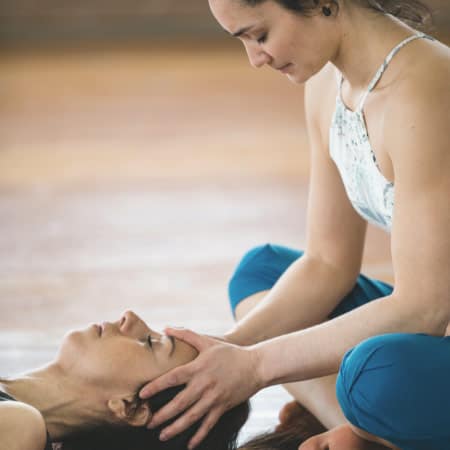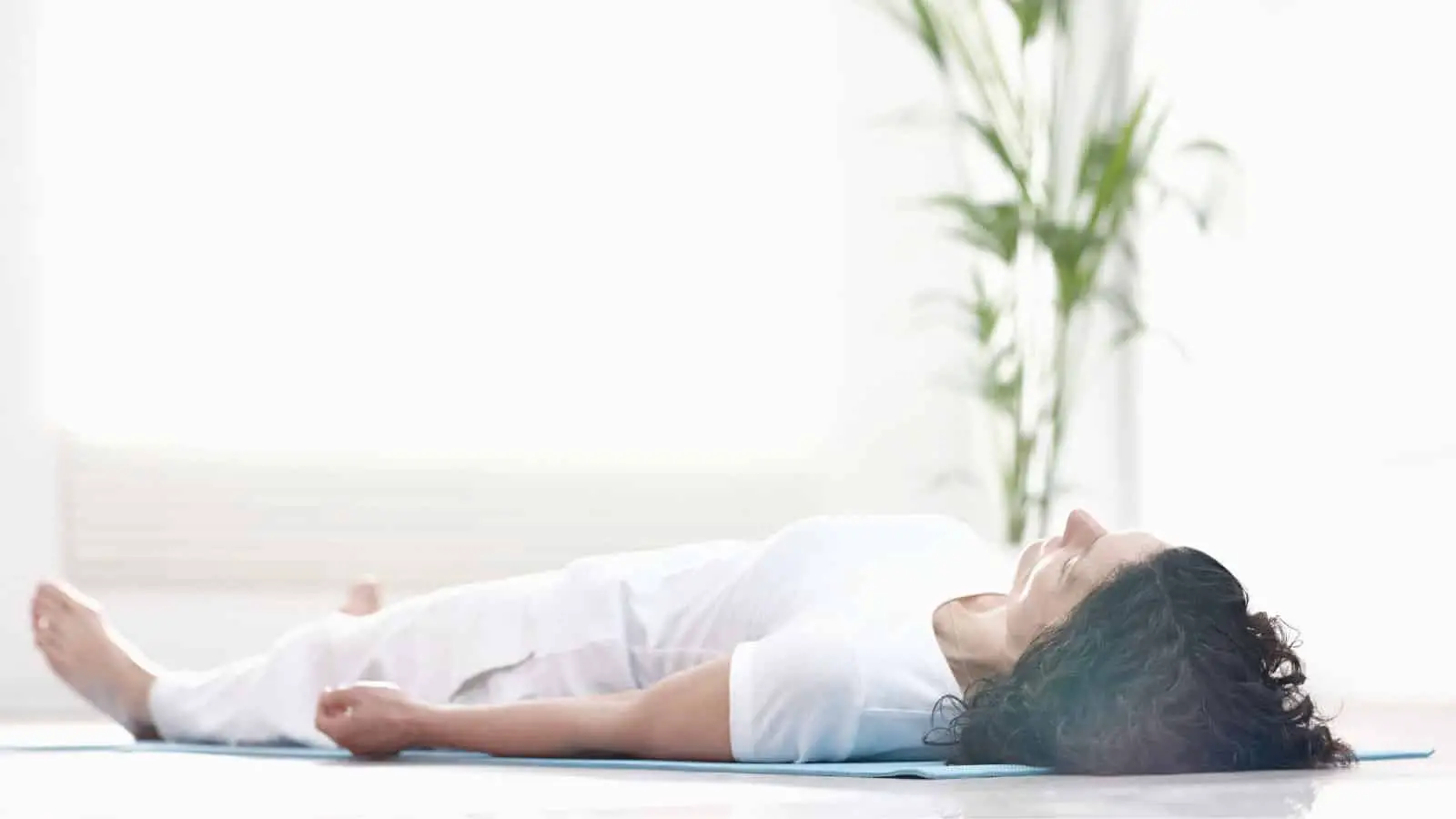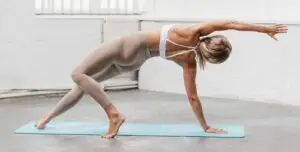There are many different kinds of stretches and poses that are a part of the typical yoga practice. However, many people don’t know that Savasana, which is done at the end of yoga practice, is an essential part of an entire yoga session.
Savasana, or “corpse pose,” is usually done at the end of yoga practice, although it can also be done at other times. This is a pose where the person lies flat on the ground, relaxed yet fully aware. This the time when the body can integrate everything it has just learned.
If you are interested in learning more about Savasana and how important it is in yoga, continue reading this post. You might learn something new that makes you better able to reach your yoga goals and improve the rest of your life.
What Does Shavasana Mean?
Savasana (also spelled as Shavasana), is the Sanskrit name of an important part of yoga practice in most yoga traditions. Usually, this is practiced at the end of a yoga sequence, although it can be used at the beginning or between other yoga poses as well. It aims at relaxing the mind and body.
The term comes from two roots in the Sanskrit language: “shava,” which means “corpse,” and “asana,” which means “seat” or “posture.” The literal English translation of “Shavasana” is “corpse pose.”
What Happens During Savasana?

During Savasana, your body will be able to relax after your session of yoga. You can relax your muscles, and your heart rate will slow down. You will be able to focus on the one thing that is still moving, which is your breath.
Being relatively still at the end of a yoga session will give your body a chance to integrate everything that it has learned while stretching and moving through different poses. Just as taking a break after studying gives your brain time to process what it has learned, this relaxation period will give your body a chance to process what it has learned while you were exercising.
Additionally, Shavasana is a good time for you to notice any areas of tension in your body. If there are any tense areas, you will be able to make a note of this and make an effort to release the tension. This can make you aware of some muscle tension issues that you may have, and it can also guide you towards specific things that you will need to do to maximize your relaxation.
What Is the Purpose of Shavasana?
The overall goal of Shavasana is to give rest to the person’s body and mind. However, it does not have the same purpose as sleep; the person is to make an effort not to fall asleep. Even though the person is lying flat on the ground, Shavasana is thought to be a somewhat active pose because the person is supposed to remain fully conscious.
The breath must be as natural as possible during Savasana. The position in which the person is supposed to lie is a neutral one; this is important so that the life force energy, or prana, can flow freely through the person’s body.
In most cases, people will enter Savasana at the end of yoga practice in order to integrate everything that has happened during the practice. However, when it is performed at the beginning, it is meant to bring the person into a relaxed state so that they can be in a better frame of mind for the rest of the practice.
When Savasana is practiced in between yoga poses, it will provide yogi with a short rest period; this can be very helpful, as some yoga positions are very strenuous.
How Long Should Shavasana last?
When someone is entering Savasana at the end of yoga practice, the pose should be held for at least five minutes. However, if the time allows, this can be extended for any amount of time that the person can successfully stay in an aware yet relaxed state.
There are some practices where this yoga pose can be held for much longer times, such as Yoga Nidra and restorative yoga. However, in situations where Savasana is being practiced as a resting pose between other poses, it is typically only held for about a minute.
How Does One Do Savasana?
In order to properly do Savasana, you will need to follow a series of steps:

- Lay on your back, flat on the floor: Most people will be able to do this, but if you have a specific injury or condition that makes this difficult, you can slightly modify this step. For example, you can put a small pillow under your knees or head if necessary. You just need to make sure that you are allowing your body to relax, so you should not be in pain.
- Extend your arms and legs out at 45-degree angles from your body: Let your feet relax to the side, and have your palms facing the ceiling.
- Slowly and repeatedly move your head from side to side: Make sure your spine is straight while you are doing this since it is important to keep a proper alignment here.
- Take deep breaths: While you are breathing, make sure that you are consciously aware of your body, which should be completely relaxed. Allow your muscles to sink towards the floor and breathe into your abdomen. Try your best not to let distractions affect what you are doing, and focus on your breathing.
- Try your best not to fall asleep: It can be easy to fall asleep at this point, especially after having tired yourself out with yoga practice. You should make an effort to stay awake, but be kind and understanding towards yourself if you fall asleep.
- When you are ready to get out of Shavasana, do so slowly: Don’t jump up quickly since this could result in a head rush that could cause you to faint.
- Slowly and gently bring your focus back to the present moment: Move your toes a little bit in an effort to start reawakening your body. Slowly open your eyes as well.
- Roll over to your right, and gently use your arm to prop yourself up: Make sure you do this slowly since moving rapidly at this point will defeat the purpose of the relaxation exercise.
- Sit up: Do this slowly, just as you have with the other steps. If you are in a yoga class, listen to the final words of the instructor. If you are at home, take time to be proud of what you have just done and give your mind the chance to refocus.
Challenges of Shavasana
Savasana can be very challenging for people with busy minds, just as is the case with meditation. These people might need to work extra hard to focus on their breathing and the present moment, quieting their minds. However, this is something that can be accomplished over time and with practice.
Some people might tend to fall asleep during Savasana easily. After all, you are tired from working out, and you might be sleep-deprived anyway. However, to derive the full benefit of the practice, you should try very hard not to fall asleep. If you feel sleepy, you should take slightly faster and deeper breaths and focus on them.
Even though a short nap might be restful, you will feel a different sort of relaxation and fulfillment if you stay fully conscious through this exercise. This can be difficult for some people, but like many other things, you will be able to do it more easily with practice.
There are also some situations where people might physically have a difficult time doing this pose. For example, someone who has back problems or some sort of discomfort when lying flat on the ground can do a modified version of the pose. An option in some cases might be to place a rolled-up blanket or pillow under the knees, which will relieve pressure in the lower back.
Another situation that may present a challenge is when a woman is in the late stages of her pregnancy. Here, the recommendation would be to lie on her left side with a pillow between her knees as an alternative asana.
Benefits of Savasana
Many people might skip Savasana when they are in a hurry or want to make their yoga practice shorter. However, doing this can deprive the person of several different benefits to the mind and body. Savasana is a mindfulness meditation practice, in addition to an exercise. There are several notable advantages to doing this pose.
Stress Relief

When you exercise, you put stress on your body. Even though it’s good for you, you are bringing it out of its natural equilibrium. Your lungs are working hard, your heart is beating quickly, and your body is probably sweating. This is true no matter what kind of exercise you are doing, particularly if it is intense exercise.
In fact, exercise activates your sympathetic nervous system and puts your body into a fight-or-flight mode. Your body produces a lot of cortisol and adrenaline, and it will shut down everything except the most critical functions.
Even though exercise is good for you in the long term, at the moment, it has the same effect on your nervous system as having to run from a predator. Savasana helps to bring your body back to its natural state. It doesn’t just rebalance your hormones, but it also helps your organs return to their normal state.
Letting your body calm down and rest after you have exercised creates calmness within you and relieves both physical and mental stress.
Assistance in Building a Routine
Even if you want to get into better shape, it can be really easy to skip exercise. Savasana can be one way in which you can successfully make exercise a regular habit. Very often, people need a reward in order to keep doing something. Building a rest period into your exercise routine can be the reward that keeps you coming back to that exercise.
Even though Shavasana can be challenging, it can also give your body and mind the rest that it needs after intense exercise. In addition, once you have learned to master mindfulness meditation, you will be able to reap the rewards of this practice as well.
An Extended Post-Workout High
Many people feel a natural high after they exercise. Even though the exercise is difficult, they are proud of themselves for having finished it, and they physically feel much better for the rest of the day. If you incorporate Shavasana into your yoga routine, you might be able to extend this feeling.
Forcing yourself to slow down and enjoy this rest period can make it so that you not only benefit from the activity of the yoga practice, but you can also take the feeling of relaxation into the rest of your day. Your body will produce a large number of feel-good neurochemicals that will help you keep your good mood for longer.
Resilience Development
Some people may think that Savasana is easy because you are just lying down. However, because it is essentially mindfulness meditation, it can be considered one of the most challenging poses in a yoga routine. It’s not just lying down and relaxing your breathing but also silencing all of the thoughts in your mind.
The truth is that taking the time to discipline your mind and body in this way can build resiliency within you. This resiliency can translate to better coping skills and other areas of your life as well. You may be more capable of dealing with external events, and you might feel more confidence and well-being internally.
Cultivating this state of mind can help you react with mindfulness to difficult situations that may arise.
Learning to Be Present and Enjoy the Moment
Savasana and other types of meditation can help you focus on the present moment. A study done in 2010 revealed that nearly half of people’s thoughts don’t have anything to do with what is going on in the present moment.
Another curious result of the study was that people tended to be less joyful when their thoughts and actions were not aligned. This means that Shavasana can potentially bring more joy to your life in all situations, even outside of yoga.
Stimulation of Root Chakra
It is the belief of expert yogis that savasana stimulates the Muladhara, or root, chakra. This is because, during this post, the entire length of your body is connected with the earth. Energizing the root chakra in this way is very grounding. This is thought to give you the ability to cultivate the stability and inner quiet that is crucial for personal growth.
Medical Benefits
Clearly, there are many psychological benefits that come with Shavasana. Not only can Savasana relieve the stress that is caused by a workout, but also the stress that you experience in daily life. It is one of the most important poses for people who are trying to reduce stress.
It has also been correlated with long-term mental health benefits. A study done in 2016 showed that people who suffered from clinical depression experienced very significant improvements in their systems when they meditated for 30 minutes prior to exercising on the treadmill twice a week for eight weeks.
However, there are some clear physical and medically measurable benefits that come with this pose as well. They are as follows:

- Better nervous system health.
- Headache relief.
- Improved lung function.
- Increased immune system function.
- Improved cardiovascular health. Savasana can normalize your blood pressure, put less stress on your heart, and reduce anxiety levels.
- Improved memory. This pose can improve your mental acuity, particularly concentration, focus, and memory.
- Higher energy level. If you do the pose regularly, it will increase the overall level of energy in your body and even help you become more productive in your daily life. If you have a chronic fatigue problem, Savasana may be able to help.
- Insomnia relief. There are different factors that can lead to insomnia, and Savasana can address many of them and ultimately result in better sleep.
- Muscle relaxation. If you have a great deal of tension in your muscles or your muscles feel chronically tired, this exercise may help.
Conclusion
If you want to be able to benefit fully from your yoga practice, you should make sure to end your sessions with Savasana. Holding this pose at the end can really help your body process and integrate everything it has learned from the workout. It can be a challenge since it can be difficult to keep your mind quiet. However, learning to do this is a valuable skill that will be well worth the effort.
Savasana comes with a variety of benefits. It can really help you get the very most out of your yoga practice, both in the short and long terms.





